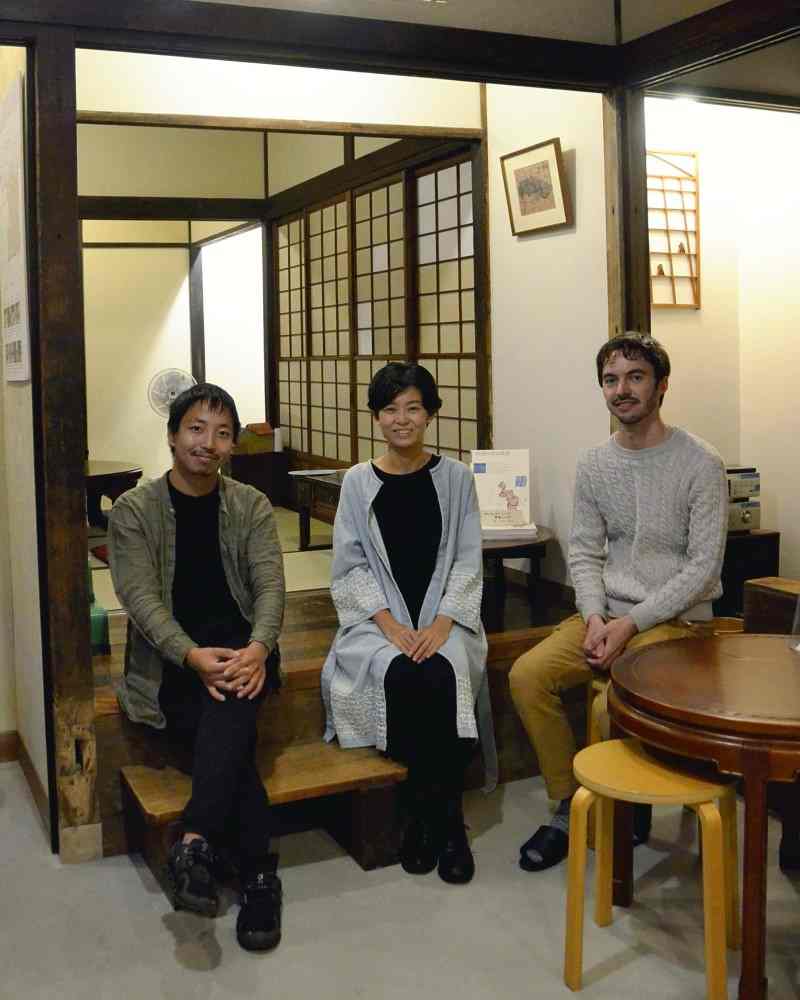November 22, 2022
TOKYO – A row house in Tokyo attached to nearly a century-old public bathhouse, which gained fame as the location for the 2012 movie “Terumae Romae” about a Roman architect transported in time to a modern-day Japanese bathhouse, has been restored and transformed into a gathering place for local residents.
In Japanese society, the public bathhouse has long served as a community hub, and the renovated space is renewing that sense of commonality and leading people to form new connections.
The bathhouse Inari-yu in Tokyo’s Kita Ward was established in the early Taisho era (1912-1926), and its wooden bathing hall and main building were built in 1930. The attached two-room row house had been moved to its present location from nearby sometime around 1927 as a dwelling for Inari-yu employees.
However, about 20 years ago, it was no longer used as a residence and become vacant, serving only for storage.

Haruka Kuryu, center, poses with other Sento & Neighborhood members in the salon of the renovated row house in Kita Ward, Tokyo, in October.
The Yomiuri Shimbun
The recent renovation was the brainchild of architect Haruka Kuryu, 41, who is involved in revitalizing communities centering on public bathhouses. She is the representative director of Sento & Neighborhood, a general incorporated association.
Kuryu focused not only on the architectural value of the Inari-yu building, but on the point that it functions as a place where the elderly can be watched over and where residents of different generations can interact with each other.
Kuryu and her colleagues led a successful campaign to have Inari-yu registered as a national tangible cultural property and apply to the U.S.-based World Monuments Fund, a global foundation dedicated to preserving cultural sites.
In 2020, the organization received a $200,000 grant from the foundation to restore and seismically retrofit the old public bathhouse and renovate the row house.
The exterior, pillars and beams of the row house, consisting of two units, were left as is while the interior was converted into a single structure. The same construction methods used in the original building were employed, such as making walls of clay on a woven bamboo lattice base. One unit was restored to its original appearance as a residence, and the other was converted into a salon with newly installed kitchen.
Craftsmen from nearby glass and housing fixture stores were commissioned for the work, and residents were invited to participate in making the clay walls.
Following the completion of the restoration, the row house opened as a community space in June. It is run by members of Sento & Neighborhood and students of nearby Taisho University, and events are held mostly on weekends in which visitors can enjoy drinks and food and take a walk around town.
“This is the first time for me to enter a public bathhouse,” said one visitor who arrived with their family, confirming the facility’s revived role as a place for interaction after a relaxing bath.
The number of public bathhouses continues to decline due to a lack of people to keep the businesses going and aging facilities. According to the Japan National Sento Association, the number of affiliated bathhouses currently stands at 1,865, about half the number 10 years ago.
Kuryu clings to the fear that the closure of public bathhouses will result in permanent changes to areas. She said such a loss alters the flow of people, causing nearby stores to shut down and residents to lose chances to interact with each other.
“Before the ‘local ecosystem’ is lost, we want to promote awareness of the culture of public bathhouses, which will help preserve and utilize them,” Kuryu said.

